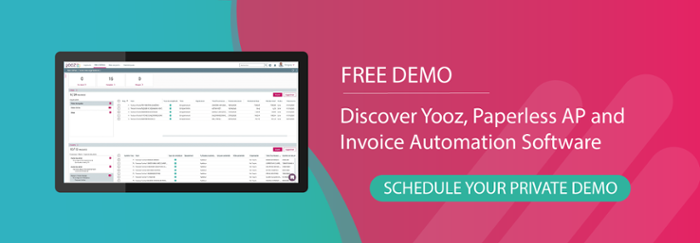Business success means safeguarding your finances at all times using strong internal controls. Unfortunately, Accounts Payable fraud poses a serious threat, capable of causing substantial financial losses and damage to company reputations. To mitigate this risk, one effective measure is implementing segregation of duties and Accounts Payable controls.
In this guide we'll explore why you should use internal controls and how segregating duties within the Accounts Payable acts as a powerful deterrent against fraud and ensures the integrity of your financial operations.
Using Internal Controls in Accounts Payable
According to US Generally Accepted Accounting Principles (GAAP) which set the accounting standards for US companies, internal controls help prevent fraud and errors and may affect the accuracy and reliability of financial reports. Using them effectively is essential to upholding the integrity of any organization's accounting operation.
Segregation of Duties
One of the most important internal controls in an Accounts Payable department is segregation of duties (SoD), where key responsibilities are divided among multiple individuals. It is vital to assign different individuals to distinct aspects of the process, such as invoice approval, recording transactions, and issuing payments.
Approvals
Apart from segregation of duties, there are several other internal controls that can be implemented in the Accounts Payable process. For example, all invoices should be reviewed and approved by someone other than the individual initiating the transaction. This practice helps to prevent fraudulent activities such as payment fraud, where payments are made to non-existent vendors or duplicate payments.
Purchase Orders
The use of purchase orders is another important internal control. Purchase orders are documents that outline the specific goods or services to be procured, their respective prices, the purchase order process, and the transaction terms. By requiring the use of purchase orders for all transactions, organizations can ensure that only authorized purchases are made.
Other Internal Controls
Additional internal controls that can be implemented include periodic edits of vendor records, the adoption of pre-numbered checks, and the use of electronic payments. These internal controls provide an extra layer of oversight and accountability in payment processes, helping to ensure the accuracy and reliability of financial reporting by providing an additional layer of oversight and accountability.
It is important to emphasize that all internal controls should undergo regular reviews and updates to ensure their effectiveness and reduce their risk exposure. As new risks emerge, organizations must adapt their internal controls accordingly to prevent fraud and errors.
To conclude, the use of internal controls is indispensable in Accounts Payable to mitigate fraud, reduce errors, and ensure data accuracy. While segregation of duties stands out as a critical control, there are several others that can be implemented. By consistently reviewing and updating internal and payable controls, organizations can stay ahead of emerging business risks, minimize human error, and maintain a high level of integrity in their accounting processes.
Segregation of Duties in Accounts Payable
We stated above that segregation of duties is one of the most important internal controls in Accounts Payable. Let's explore that concept - why dividing responsibilities is so important - in further depth and why it is so critical for safeguarding against fraud or errors.
The fundamental principle behind this control mechanism is having more than one individual required to complete a task or a series of tasks. In the case of invoicing or in Accounts Receivable, it means that no single individual is granted complete authority over any specific aspect of the Accounts Payable process. Instead, various individuals are assigned distinct responsibilities, establishing a system of checks and balances.
For example, one person may be responsible for approving invoices, while another handles recording transactions, and a third individual oversees actually issuing payments. By dividing these responsibilities among multiple individuals, no one person has absolute control over the entire payment process. Instead, there is a system of checks and balances that minimize the chance of fraud or errors.
The idea of segregating duties is important because when more than one person is involved in the process, it becomes much harder for any individual to commit fraud without detection. For example, if one person is responsible for approving invoices and another person responsible for issuing payments, they could easily create false invoices and approve them for payment, resulting in fraudulent payments. However, if these responsibilities are separated, it would be much harder for a fraudster to carry out such a scheme undetected.
However, it is crucial to emphasize that segregation of duties serves as a deterrent against fraud and errors by ensuring that no single individual has the ability to manipulate the system for personal gain. This holds particular significance given the increasingly high risk of fraud in the Accounts Payable process, as studies reveal that Accounts Payable fraud is one of the most prevalent types of misconduct committed by employees.

Which Duties Should be Segregated?
Here are some examples of duties that should be overseen by more than one person in order to ensure checks and balances are in place:
- Purchase orders: the creation and approval of purchase orders should involve different individuals.
- Invoice processing: invoice verification and processing should involve multiple people.
- Payment authorization: approval levels and roles should be clearly defined throughout the entire process. These individuals should be different from those involved in other purchasing or processing steps.
- Bank Reconciliations: multiple individuals should be involved in the bank reconciliation process to prevent discrepancies or fraudulent activity. Specifically, these should not be employees involved in any other part of the transaction process.
Of course, specific duties to be overseen by more than one person may vary based on the organization's size and internal control requirements. While complete separation is ideal, it may not always be possible.
How to Implement Accounts Payable Segregation of Duties
Here are five steps for organizations to follow when implementing segregation of duties in Accounts Payable:
Step 1: Analyze the current process
Identify the tasks and responsibilities involved in the process including invoice processing, data entry, payment approvals, vendor setup, and reconciliation.
Step 2: Assign key roles and responsibilities
Once you have identified the key roles, assign them to different individuals or teams to ensure that no person has too much control over multiple tasks that could create a conflict of interest. One way to do this is to establish a duties matrix which clearly matches roles to responsibilities.
Step 3: Define clear authorization levels
Establish clear authorization levels and limits for each role involved in the process.
Step 4: Document policies and procedures
Develop comprehensive policies and procedures that outline the appropriate segregation of duties controls in the Accounts Payable process. Clearly define roles and responsibilities in addition to steps required for invoice payment processing, payment approvals, and even vendor management.
Step 5: Regularly review and monitor compliance
Conduct regular reviews and audits to ensure compliance with the segregation of duties controls. Make adjustments as necessary to address any identified weaknesses or gaps.
Remember that segregation of duties is part of a broader internal controls framework, and it's important to ensure that relevant stakeholders are involved in the process and understand their responsibilities.
By implementing these policies and procedures, organizations can establish a system of checks and balances that prevents fraud and ensures the accuracy of financial reporting.

The Benefits of Segregation of Duties in Accounts Payable Internal Controls
Implementing segregation of duties in Accounts Payable provides numerous benefits, including:
Preventing fraud and errors
By segregating duties, an organization can establish a system of checks and balances that prevents fraud and errors. When multiple individuals are involved in pay controls, it's much harder for any one person to commit fraud or make errors without being detected.
For example, if one employee is responsible for both approving invoices and issuing payments, they could potentially create a fictitious vendor and approve a payment to that vendor. However, if multiple individuals are involved in the process, it's much more difficult for any one person to carry out fraudulent activities without being caught.
Improving the accuracy and reliability of financial reporting
When there is a segregation of duties in Accounts Payable, it helps ensure that transactions are accurately recorded in the accounting system. This in turn improves reporting accuracy and reliability. In contrast, when there is no segregation of duties, there exists a greater risk of errors and inaccuracies occurring in the accounting records.
For example, if the same person who approves an invoice is also responsible for recording it in the accounting system, they may accidentally record the wrong amount or code the transaction to the wrong bank account.
Increasing transparency and accountability
Segregation of duties increases transparency and accountability in the Accounts Payable process. When multiple individuals are involved in the process, it's easier to trace the flow of financial transactions and identify any irregularities. This helps increase transparency and accountability, making it easier to detect and prevent fraud.
Enhancing the efficiency of the accounts payable process
Segregation of duties can also enhance the overall efficiency of the Accounts Payable process. By assigning different individuals to each role, it ensures that each person is responsible for a specific task, which reduces the risk of bottlenecks and delays. This, in turn, can help improve cash flow and supplier relationships.
Empower Internal Controls with Accounts Payable Automation
Embracing automation and accounting software to empower more internal control is a strategic move that organizations can no longer afford to overlook. By harnessing the power of technology, businesses can streamline their processes, enhance efficiency, and mitigate risk.
Automation not only reduces the potential for human error but provides real-time visibility into operations, enabling proactive strategic decision-making. With the right tools and systems in place, companies can strengthen their internal controls, streamline their cash flow, and ensure compliance with regulatory requirements.
To learn more about how Yooz can help you move forward in today's digital landscape, schedule a free demo today.
FAQs
How does Yooz support the segregation of duties in accounts payable to enhance financial controls?
Can Yooz help in setting up automated approval hierarchies to adhere to our internal controls and segregation of duties policies?
How does Yooz ensure that changes to vendor information adhere to segregation of duties principles?
In the context of segregation of duties, how does Yooz provide visibility and accountability in the accounts payable process?







